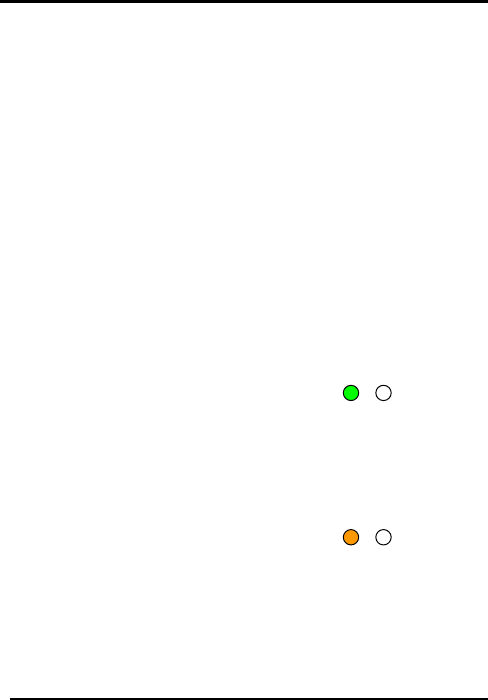User's Manual
Table Of Contents
- 1. General Information
- 2. Technical Specifications
- 3. Installation
- 4. Wiring Instructions
- 5. Reader Functionality
- 5.1 Transmit Mode
- 5.2 Programming the AYC- F/G/M60 Series
- Programming Menu
- Entering Programming Mode
- Exiting Programming Mode
- Selecting Keypad Transmission Format
- Keypad Transmission Format Option Number
- Option 1: Single Key, 6-Bit Wiegand (Rosslare Format)
- Option 2: Single Key, 6-Bit Wiegand Nibble and Parities
- Option 3: Single Key, 8-Bit Wiegand Nibbles Complemented
- Option 4: 4 Keys Binary + Facility Code, 26-Bit Wiegand
- Option 5: 1 to 5 Keys + Facility Code, 26-Bit Wiegand
- Option 6: 6 Keys BCD and parity bits, 26-Bit Wiegand
- Option 7: Single Key, 3x4 Matrix Keypad (MD-P64)
- Option 8: 1 to 8 Keys BCD, Clock & Data
- Option 9: Single Key, 4-bit Wiegand
- Selecting Proximity Card Transmission Format
- Changing the Programming Code
- Changing the Facility Code
- Setting the Backlight and Reader Format
- Return to Factory Default Settings
- Replacing a Lost Programming Code
- 6. Controller Functionality
- 6.1 Normal, Secure, and Master Users
- 6.2 Modes of Operation
- 6.3 Auxiliary Input & Output
- 6.4 Door Alarms
- 6.5 Internal Case and Back Tamper
- 6.6 Lockout Feature (Keypad / Card Tamper)
- 6.7 Request to Exit (REX) Function
- 6.8 Secure Application Appurtenances
- 6.9 Programming the AYC- F/G/M60
- Programming Menu
- Entering Programming Mode
- Exiting Programming Mode
- Changing Lock Strike Code
- Changing Auxiliary Code
- Changing the Programming Code
- Changing the Normal / Secure Code
- Changing the Normal / Bypass Code and Door Chime Settings
- Setting Fail Safe/Secure Operation, Tamper Siren and Lock Strike Release Time
- Defining the Auxiliary Input and Output
- Quick Reference Guide for Auxiliary Mode Setting
- Detailed Reference Guide
- Setting the Lockout Feature
- Setting the backlight behavior
- Enrolling Primary and Secondary Codes
- Deleting Primary and Secondary Codes
- Relay Codes Assignment
- Relay Code Assignment using Search Method
- Pin Code Length / Factory Default Settings
- Replacing a Lost Programming Code
- Replacing a Lost Normal / Secure Code

AYC-Qx4 family manual
Page 29
Secure User
A Secure User must have a Primary and Secondary Code
programmed; the two codes must not be the same. The Secure
User can gain access when the AYC- F/G/M60 is in any of its three
modes of operation. In Normal Mode the Secure User must use
their Primary Code to gain entry. In Secure Mode the Secure User
must present both their Primary and Secondary Codes in order to
gain entry.
Master User
A Master User must have both Primary and Secondary Codes
programmed with the same code. The Master User can gain
access during any mode of operation by presenting their PIN
code and/or Proximity card once to the controller. (The Master
User is convenient but is less secure than a Secure User.)
6.2 Modes of Operation
The AYC- F/G/M60 has three modes of operation:
Normal Mode
MODE LED is green
Normal Mode is the default mode.
In Normal mode the door is locked until a Primary Code is
presented to the controller. Special codes such as Lock Strike
Code and Auxiliary Code are active in Normal mode. (See pages
35-36 for more information)
Bypass Mode
MODE LED is orange
In Bypass Mode, access to the
premises is dependent on whether the controller's Lock Strike
Relay is programmed for Fail Safe Operation or Fail Secure
Operation. When the Lock Strike is programmed for Fail Secure
Operation, the door is locked until the "*" button is pressed. When
the Lock Strike is programmed for Fail Safe Operation, the door is
constantly unlocked.
Mode/Transmit
Door/Program
Green
Mode/Transmit
Door/Program
Oran
g
e










